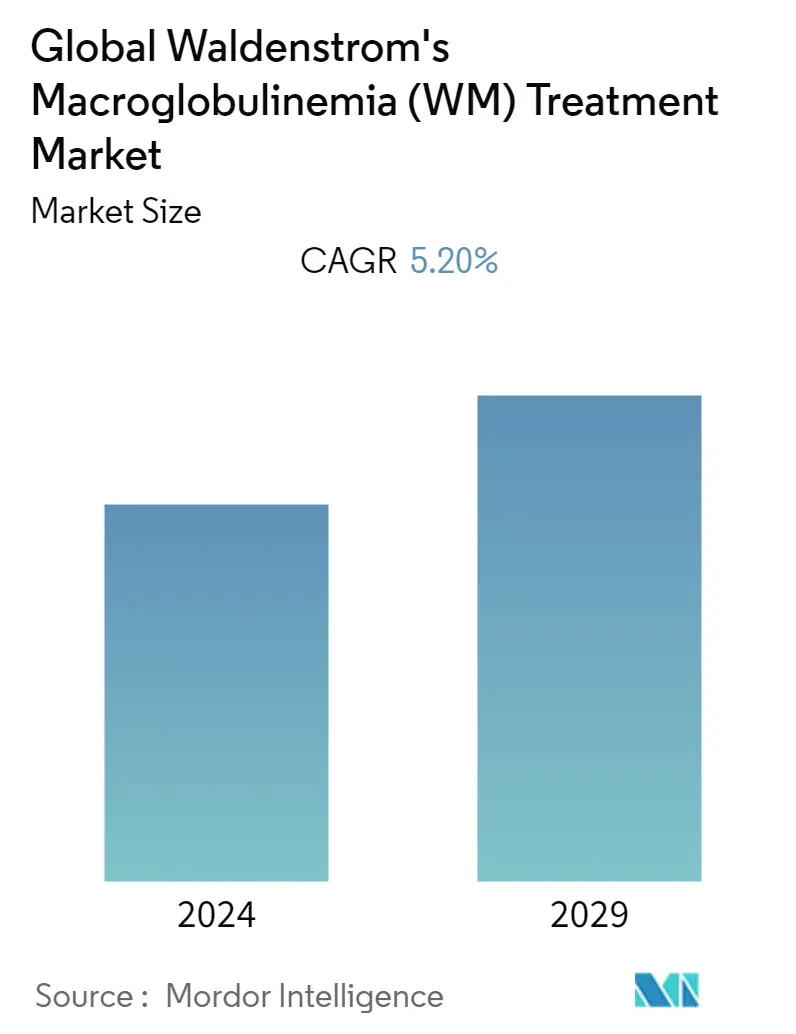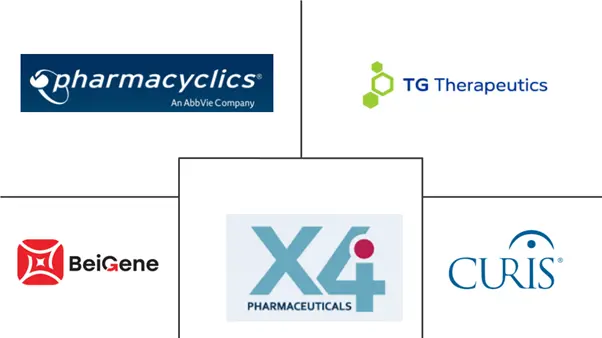Market Size of Global Waldenstrom's Macroglobulinemia (WM) Treatment Industry

| Study Period | 2019 - 2029 |
| Base Year For Estimation | 2023 |
| Forecast Data Period | 2024 - 2029 |
| CAGR | 5.20 % |
| Fastest Growing Market | Asia-Pacific |
| Largest Market | North America |
Major Players
*Disclaimer: Major Players sorted in no particular order |
Waldenstrom Macroglobulinemia Market Analysis
Waldenstrom's Macroglobulinemia (WM) treatment market is anticipated to expand at a CAGR of 5.2% during the forecast period (2022-2027).
The worldwide health crisis of COVID-19 has affected the healthcare industry including its operations, commercial sales, regulatory interactions and inspections, and clinical trial recruitment and participation. COVID-19 has resulted in significant governmental measures being implemented to control the spread of the virus, including quarantines, travel restrictions, social distancing, and business shutdowns. Additionally, the commercial or clinical supply of the medicines and drug candidates has also been impacted due to the shutdown of the company's, or our third-party manufacturing facilities, distribution channels, and transportation systems, or shortages of raw materials and drug products which has reduced the company's revenue. For instance, AbbVie reported a 12.4% decrease in the net revenue generated by Imbruvica, used for waldenstrom's macroglobulinemia, in 2020 as compared to 2019.
The increasing prevalence and incidence of cases of waldenstrom's macroglobulinemia and increasing drug approvals by the regulatory bodies are escalating the growth of the market. The growth of the market is attributed to the increasing development of targeted and combination therapies across the globe. Furthermore, the rising geriatric population is expected to propel market growth. For instance, according to the statistics published by MedlinePlus genetics, it was observed that around 1,000 - 1,500 people are diagnosed with waldenstrom's macroglobulinemia (WM) each year in the United States, and is highest among individuals aged 60-79 years with an incidence rate of 3.4 per million among men and 1.7 per million among women in the United States. In addition, waldenstrom is predominantly affecting Caucasians.
Growing awareness about waldenstrom macroglobulinemia in low and middle-income countries, development of new diagnostic methods, rise in the need for novel therapies, and a constant number of clinical trials and heavy investments by the pharmaceutical companies and the government, can create remunerative opportunities and are speculated to bolster the market growth in the foreseeable future. For instance, in Nov 2020 AstraZeneca initiated a Phase II trial of bendamustine, rituximab, and the second-generation BTK Inhibitor Acalabrutinib in previously untreated waldenstrom's macroglobulinemia patients which is expected to complete by 2030. Bristol-Myers Squibb developing a Dasatinib drug in patients with waldenstrom macroglobulinemia (WM) progressing on Ibrutinib is under Phase 1 trial and is expected to be complete by 2024. BeiGene's Brukinsa, Abbvie's Imbruvica, and Gilead's ibrutinib are the approved drugs that are being prescribed to the patients. Takeda has the highest number of completed clinical trials for waldenstrom's macroglobulinemia.
However, the Inadequate accessibility of disease-specific treatment and unmet needs including lack of curative therapies, high treatment cost, dearth of skilled workers, and strict safety guidelines are projected to impede the growth of the market.
Waldenstrom Macroglobulinemia Industry Segmentation
As per the scope of the report, waldenstrom macroglobulinemia, also known as lymphoplasmacytic lymphoma, is an indolent subtype of non-Hodgkin lymphoma that originates in the bone marrow and starts producing abnormal white blood cells which hinder the normal functioning of the body and causes major complications. The major factor responsible for developing this disorder is the release of a hormone called interleukin (IL-6) from dendritic cells which aids in the growth of plasmacytoid lymphocytes.
It is suspected that the treatment options are bound to improve shortly, albeit at the cost of making its management increasingly complex. The Global Waldenstrom's Macroglobulinemia (WM) Treatment Market is segmented by treatment type (plasmapheresis, targeted therapy, chemotherapy, and Others) and geography (North America, Europe, Asia-Pacific, Middle East and Africa, South America). The report offers the value (in USD million) for the above segments. The market report also covers the estimated market sizes and trends for 17 countries across major regions globally.
| By Treatment Types | |
| Plasmapheresis | |
| Targeted therapy | |
| Chemotherapy | |
| Others |
| Geography | |
| North America | |
| Europe | |
| Asia-Pacific | |
| Middle East and Africa | |
| South America |
Global Waldenstrom's Macroglobulinemia (WM) Treatment Market Size Summary
The Waldenstrom's Macroglobulinemia (WM) treatment market is poised for significant growth, driven by the increasing prevalence of the disease and the development of targeted and combination therapies. The market is experiencing a surge in drug approvals, which is further propelling its expansion. The rising geriatric population, particularly those aged 60-79, is contributing to the growing incidence of WM, with a notable impact on Caucasian individuals. Despite challenges such as inadequate accessibility to disease-specific treatments and high costs, the market is bolstered by growing awareness in low and middle-income countries, advancements in diagnostic methods, and substantial investments from pharmaceutical companies and governments. The targeted therapy segment, which includes monoclonal antibodies and other agents, is expected to dominate the market due to its efficacy in minimizing side effects while effectively treating cancer.
North America holds a dominant position in the WM treatment market, attributed to the high incidence of the disease and the presence of major cancer foundations and medical institutions. The region benefits from increased research and development activities, government grants, and a robust healthcare infrastructure. The market is moderately competitive, with major players like BeiGene, Curis, Inc., and TG Therapeutics leading the charge. Recent regulatory approvals and ongoing clinical trials are expected to further enhance the market landscape. The COVID-19 pandemic has also opened new avenues for targeted therapy, potentially increasing its adoption. As the market continues to evolve, the entry of smaller players is anticipated, driven by rising patient awareness and the introduction of new therapies.
Global Waldenstrom's Macroglobulinemia (WM) Treatment Market Size - Table of Contents
-
1. MARKET DYNAMICS
-
1.1 Market Overview
-
1.2 Market Drivers
-
1.2.1 Growing Burden of Target Diseases
-
1.2.2 Development and Commercialization of effective Product
-
-
1.3 Market Restraints
-
1.3.1 Huge cost of treatment and lack of skilled persons
-
-
1.4 Porter's Five Force Analysis
-
1.4.1 Threat of New Entrants
-
1.4.2 Bargaining Power of Buyers/Consumers
-
1.4.3 Bargaining Power of Suppliers
-
1.4.4 Threat of Substitute Products
-
1.4.5 Intensity of Competitive Rivalry
-
-
-
2. MARKET SEGMENTATION
-
2.1 By Treatment Types
-
2.1.1 Plasmapheresis
-
2.1.2 Targeted therapy
-
2.1.3 Chemotherapy
-
2.1.4 Others
-
-
2.2 Geography
-
2.2.1 North America
-
2.2.2 Europe
-
2.2.3 Asia-Pacific
-
2.2.4 Middle East and Africa
-
2.2.5 South America
-
-
Global Waldenstrom's Macroglobulinemia (WM) Treatment Market Size FAQs
What is the current Global Waldenstrom's Macroglobulinemia (WM) Treatment Market size?
The Global Waldenstrom's Macroglobulinemia (WM) Treatment Market is projected to register a CAGR of 5.20% during the forecast period (2024-2029)
Who are the key players in Global Waldenstrom's Macroglobulinemia (WM) Treatment Market?
BeiGene, TG Therapeutics, Inc., Curis, Inc., X4 Pharmaceuticals, Inc. and Pharmacyclics LLC are the major companies operating in the Global Waldenstrom's Macroglobulinemia (WM) Treatment Market.

